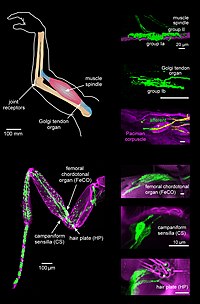
Photo from wikipedia
Perceived heaviness is clearly a function of muscle activity: objects feel heavy, in part because they are lifted with more force than lighter feeling objects. Recent research showed that participants… Click to show full abstract
Perceived heaviness is clearly a function of muscle activity: objects feel heavy, in part because they are lifted with more force than lighter feeling objects. Recent research showed that participants scale their perceptions to the ratio of muscle activity to lift acceleration during elbow lifts (Waddell et al. J Exp Psychol Hum Percept Perform 42:363–374, 2016). The current study sought psychophysiological functions relating perceived heaviness to EMG and peak lift acceleration across multiple lifts employing different muscles as prime movers. Participants lifted objects with three arm lifts—shoulder, elbow, and wrist—and reported perceived heaviness. In each lift, EMG was recorded from the anterior deltoid, biceps brachii, and forearm flexors, and peak angular acceleration was recorded about each joint. The resulting psychophysiological functions revealed the hypothesized ratio of muscle activity to peak lift acceleration in all lifts. Principal component regressions showed that the EMG of the forearm flexors and peak acceleration of the lifting joint were most relevant for perceived heaviness. The special role of forearm flexors in perceiving heaviness across different lifts was interpreted in terms of the invariant structure of the inertia tensor about the wrist.
Journal Title: Experimental Brain Research
Year Published: 2017
Link to full text (if available)
Share on Social Media: Sign Up to like & get
recommendations!